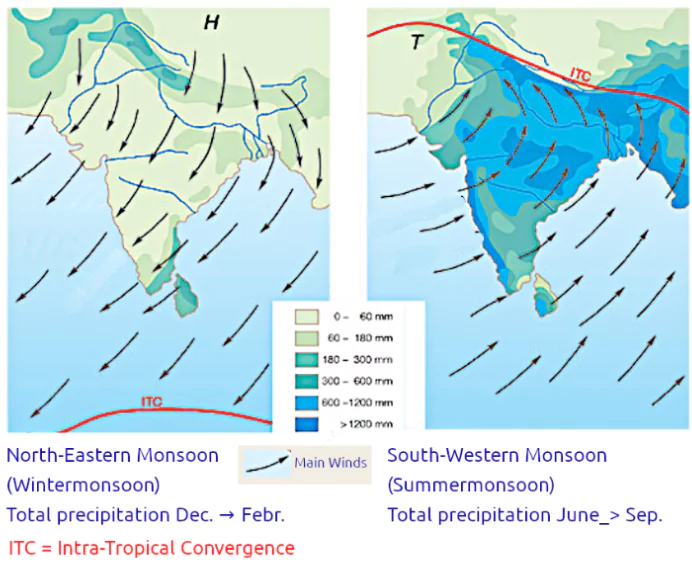A recent study has shed light on the effects on Indian Monsoon by seasonal changes in the Arctic sea ice levels.
About the Study
- Published In: The Study is published in the journal Remote Sensing of Environment
- Conducted By: The research is a collaboration between India’s National Centre for Polar and Ocean Research (NCPOR), under the Ministry of Earth Sciences, and South Korea’s Korea Polar Research Institute.
- Subject: To check how the Arctic sea ice levels affect atmospheric circulations that in turn influence the Indian Summer Monsoon Rainfall.
 Data Source: Observational data from the period of 1980 to 2020 were used along with climate models (specifically Coupled Model Intercomparison Project Phases 5 and 6)
Data Source: Observational data from the period of 1980 to 2020 were used along with climate models (specifically Coupled Model Intercomparison Project Phases 5 and 6)- Findings:
- Role of Climate Change: Climate Change accelerates the reduction of Arctic sea ice and exacerbates the variability and unpredictability of the ISMR
- Lower Arctic sea ice can lead to more frequent and severe droughts in western and peninsular India regions while causing excessive rainfall and flooding in central and northern India.
- Influence Monsoon Onset: Lower sea ice levels in the upper latitudes (mainly in the Barents-Kara Sea region encompassing the Hudson Bay, the Gulf of St. Lawrence and the Sea of Okhotsk) delay the monsoon’s onset rendering it more unpredictable.
- Changes in Several Atmospheric Systems:
- Increased Sea Ice Levels in the Central Arctic: It results in the heat transfer from the ocean to the atmosphere triggering a cyclonic circulation at slightly lower latitudes (North Atlantic)
- Rossby Waves:The cyclonic circulation bolsters the Rossby waves resulting in high pressure over northwest India and low pressure over the Mediterranean region.
- These are fast-flowing streams of air high in the atmosphere created by the earth’s rotation and differences in temperature and weather systems that move west to east.
- Strengthening Jet Stream: The circulation strengthens the Asian jet stream over the Caspian Sea, causing the subtropical easterly jet (a jet stream blowing over the Indian subcontinent during summer to shift northward)
- An anomalous high pressure region is created over Central Asia as a result disrupting atmospheric stability over the Indian landmass and bringing more rain over western and peninsular India.
- Low sea ice over the Barents-Kara Sea region:
- It triggers a series of air currents that produce an anomalous high pressure over southwest China.
- The heat from the Barents-Kara sea creates an anticyclonic circulation (calm, clear skies) over northwest Europe disturbing the upper atmospheric region over subtropical Asia and India.
- The instability along with high surface temperature of the Arabian Sea promotes high rainfall over northeastern India while leaving central and northwest regions of the country with deficient rainfall.
Enroll now for UPSC Online Course
Indian Monsoon
Monsoon is a seasonal change in the direction of the prevailing, or strongest, winds of a region.
- Indian Summer Monsoon Rainfall: India gets southwest monsoon winds in the summers (formation of an intense low-pressure system ie. ITCZ due to differential heating over the Tibetan Plateau)
- Coriolis Force: The Coriolis Force deflects the Trade winds towards the Indian landmass after they cross the equator.
- The winds blowing over the Arabian Sea picks up moisture and deposit that as rain over India.
- Branches: The southwest monsoon splits into two branches ie. The Arabian Sea arm (brings rain to the west coast) and the Bay of Bengal arm (brings rain to India’s eastern and northeastern parts) over the landmass.
- Convergence: The arms finally converge over Punjab and Himachal Pradesh as the Arabian Sea arm moves inward and the Bay of Bengal arm moves along the Himalaya.
- India Winter Monsoon Rainfall: The northeast monsoons is the reversal phase of monsoon during the winters (due to the high-pressure cells that are formed over the Siberian and Tibetan plateaus.)
 Factors affecting the onset of monsoon Factors affecting the onset of monsoon
- Intense low-pressure formation over the Tibetan Plateau due to intense heating of landmass during summers
- The permanent high-pressure cell in the South of the Indian Ocean near madagascar
- Subtropical jet stream
- African Easterly jet (Tropical easterly jet)
- low-pressure systems (or monsoon depressions), presence of ITCZ (InterTropical Convergence Zone)
- Global Atmospheric Circulations: The surface temperatures of the Indian, the Atlantic, and the Pacific Oceans affect the ISMR.
- The Circum-Global Teleconnection (CGT): It is a large-scale atmospheric wave flowing at the mid-latitudes, seems to significantly influence the monsoon as well.
|
![]() 9 Sep 2024
9 Sep 2024
 Data Source: Observational data from the period of 1980 to 2020 were used along with climate models (specifically Coupled Model Intercomparison Project Phases 5 and 6)
Data Source: Observational data from the period of 1980 to 2020 were used along with climate models (specifically Coupled Model Intercomparison Project Phases 5 and 6)